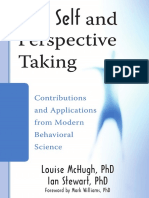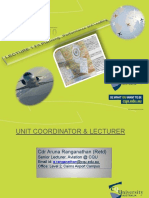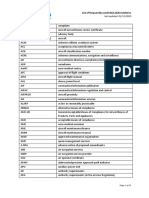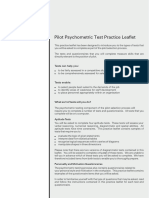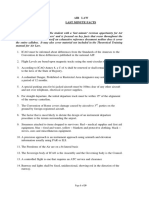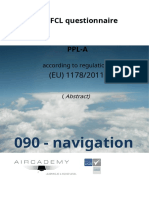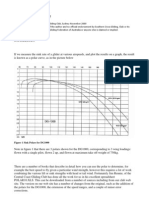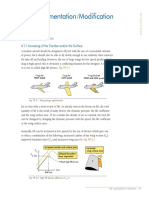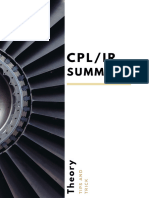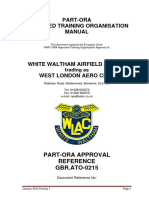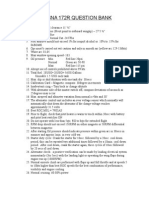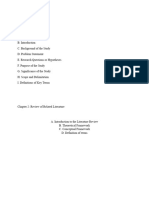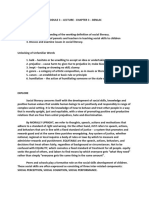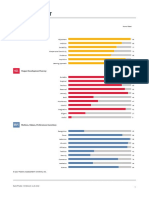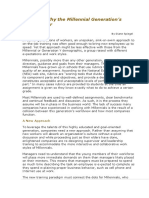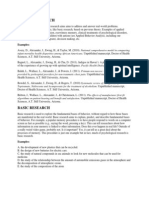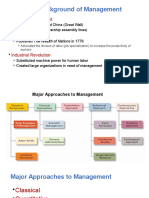DLR - Tips and Tricks PDF
DLR - Tips and Tricks PDF
Uploaded by
Selda CoktasarCopyright:
Available Formats
DLR - Tips and Tricks PDF
DLR - Tips and Tricks PDF
Uploaded by
Selda CoktasarOriginal Title
Copyright
Available Formats
Share this document
Did you find this document useful?
Is this content inappropriate?
Copyright:
Available Formats
DLR - Tips and Tricks PDF
DLR - Tips and Tricks PDF
Uploaded by
Selda CoktasarCopyright:
Available Formats
German Aerospace Center (DLR) Tips and
Aviation and Space Psychology
Hamburg, Germany Tricks
Dear Candidate,
The German Aerospace Center (DLR) provides you with free training software and
information to assist you during your preparation for a DLR assessment. It is important
that you make extensive use of this opportunity. Do not attend a DLR assessment if you
have not had at least ten days time to thoroughly practise with all training tools and read
all information texts.
Our CBTs will not enhance your aptitude (synonym: ability) for spatial orientation,
perception, concentration, etc. . No software is able to do this since these aptitudes are –
like talents – genetically and somatically determined to a large extend. However the CBTs
will familiarize you with the test principles and increase your test specific skills. Doing so
has several advantages:
Being well trained will help you to really achieve your own individual maximum
performance in the actual test.
Having a comprehensive idea of what to expect in the actual assessment will help you
to overcome excitement and fear prior to the assessment.
Furthermore our CBTs and information texts are meant to put into perspective some
of the rumours and legends you might hear and read from people with ‘DLR
experience’ or other ‘experts’. Although there are generally no objections against
sharing impressions about the DLR with others there are still risks to be considered
when asking others ‘what DLR is looking for’ or for their recommendations on ‘how
to pass the DLR’: As an applicant it is very hard to judge the benchmarks and all the
details of one’s own assessment process. What had worked for one person might not
work for others, because their strengths and weaknesses might be in totally different
domains! Therefore do not rely on well-intentioned hints and recommendations from
other sources than those authorized by the DLR. Extra caution is advisable if
somebody offers you information or ‘DLR Training’ for money.
The Competence Chain
Operating an aircraft involves various tasks and challenges and pilots need to have certain
physical, mental and social qualities to meet these challenges. The physical qualities can
be checked by an Aviation Medical Examiner while the mental and social qualities require
a psychological examination like the one the DLR Aviation Psychologists conduct.
We differentiate between aptitudes, personality traits, skills, and attitudes. Acceptable
perception, concentration, memory function, spatial orientation, motor coordination,
multitasking capacity, and logical reasoning are among the most important aptitudes. A
beneficial personality structure (regarding for example rigidity, introversion, stress
resistance, etc.) is another important aspect of a pilot’s competence. Aptitudes and
personality are rather stable and hard to change because they are genetically and
somatically determined to a large extend. Skills (e.g. geographical knowledge, English
language or CRM skills) and attitudes (e.g. the preference of certain techniques or the
QMH-DLR-ME-HH- DLR_-_Tips_and_Tricks_20090417.doc page 1 / 9 17.04.2009 (Rh)
degree of a person’s customer orientation) on the other hand are more easily influenced
by training and experience.
Just as the strength of a chain is determined by its weakest link the overall competence
of a pilot is determined by his/her most drastic deficiency. Example: How reliable would
you consider a pilot who has impressive skills, a favourable personality, and good
attitudes, but due to a deficiency in spatial orientation (an aptitude) tends to mix up left
and right or has difficulties identifying another aircraft’s position in reference to his/her
own? Take a second example: Let us assume a person has no deficiency in his/her
aptitudes, plus favourable personality traits and attitudes. However, due to a lack of
English language skills he/she is unable to understand and adequately reply to the flight
instructor’s or controller’s messages – especially in non-standard situations. The overall
suitability (as a pilot) of this candidate has to be considered as rather poor. The fact that
English language skills can be improved more easily by training than an impaired spatial
orientation does not alter the finding that at the moment of assessment the requirements
for a positive recommendation are not met by both candidates discussed here.
Although the DLR recommendation policy does not tolerate any significant deficiencies,
the good news is, you do not have to be Superman or Superwoman either! Performing
average in all categories of aptitude, personality, attitude, skill, stress resistance etc., is
totally sufficient to receive the Aviation Psychologists’ approval.
General remarks on psychometric testing
Be prepared for different kinds of tests. Some have a so called ‘multiple-choice’ design:
you choose which of the offered answers you consider correct. In DLR tests there is
exactly one correct answer, not more - not less. For all multiple choice tests it is a good
strategy to quickly do a first run and work only on questions that you immediately
understand. Do not loose time agonising about a difficult question while there is still a
chance of easier ones to come up! If you have time left, start a second run with the
leftover questions and again set aside the most difficult ones.
In these sorts of tests you do not get extra credit if you finish before the time allowance
has run out. Therefore, if you have time left use it to check your answers. The multiple-
choice design is typically used in tests for English, maths, physics, or aeronautical
knowledge.
Other tests are more dynamic. Some tests have increasing difficulty levels while in others
the difficulty level remains stable. Some tests are computer paced, while in others you
determine how fast you go. Some include auditory information via headphones, others
contain only visual material. As a general rule for all tests (unless stated otherwise):
always work as fast and at the same time as accurately as possible! I. e. if you find a task
rather easy, try to do it faster. If you realise you have become so fast you started making
mistakes or omissions, consider reducing your working pace in order to raise the
accuracy. In other words: find a good balance between quality and quantity!
Then there are the questionnaires aiming at personality and/or attitudes. These
questionnaires are not tests that you pass or fail, they are meant to give the DLR a first
impression on who you are as an individual. Your very own personal opinion is needed!
Therefore these questionnaires have no strict time allowance – everybody has to answer
all questions. However, going through it as spontaneous as possible usually leads to the
most accurate picture. So do not think about each and every question as if it were a test,
give the first answer that comes to your mind without wasting time fantasizing ‘what’s
behind’ it.
QMH-DLR-ME-HH- DLR_-_Tips_and_Tricks_20090417.doc page 2 / 9 17.04.2009 (Rh)
When training with our CBTs, do not expect the real tests to be 100% identical. Small
features may differ. Therefore, even after intensively training with the CBTs, please,
carefully read the instructions and pay close attention to all demonstration items of the
real test in your DLR assessment.
Expect most tests to be computer assisted with a touch screen for your inputs, so
proficiency in typing on a keyboard or using a computer mouse is not of a benefit.
However, we cannot exclude that some tests are in paper/pencil format.
Training for the Basic Aptitude – Tests
Carry out each CBT as many times as you need to come to the impression that you are
fully familiar with the testing principles and your results have not significantly increased
during the last couple of runs. Normally, between five and ten runs are minimum to get
to this point. The progress usually resembles the prototypical learning curve shown below
(Figure 1) with significant gains in the beginning and an asymptotic convergence to your
own individual maximum. Use the DLR Training Record to keep record of your individual
results in each run (see respective chapter).
100
Percentage of Individual Maximum
0
1 2 3 4 5 6 7 8 9 10
Number of Run
Figure 1: Prototypical learning curve of a fictitious person in a fictitious CBT. Note that in this case
the individual maximum is practically achieved in run number 6. Further runs do not
increase the individual results significantly. Attention! Please take into account that you
might need to perform more than just six runs to achieve your own individual
maximum!
It is not recommendable to run a specific CBT more than once per day. The training
effect of, say, one run per day for five days is higher and more stable compared to doing
five runs on one single day.
Regarding the psychomotor and multitasking test MIC (Monitoring and Instrument
Coordination), please note, that in this case it leads to optimum results if you do the
joystick training during the extensive exercise period in the actual test. More than 80% of
the total time in the MIC is (not scored) training time in order to accomplish the full
learning curve under realistic and standardized conditions. Trying to prepare for the MIC
with the help of flight simulator programmes or other commercial software is not
completely useless, but involves the risk of customizing to differing dynamics and loosing
your flexibility to react adequately to the actual characteristics of the real test. Keep in
mind, the MIC is not a flight simulator! It is a test aiming at your eye-hand-coordination
and your flexibility to adapt to and control an unfamiliar and highly dynamic
QMH-DLR-ME-HH- DLR_-_Tips_and_Tricks_20090417.doc page 3 / 9 17.04.2009 (Rh)
environment. However, it is very important to mentally prepare for this test by thoroughly
and repeatedly going through the PDF ‘Information and Preparation MIC’. Having fully
internalized all tasks and the nature of the displayed instruments leaves mental capacity
for the actual accomplishment of the task.
All tests aiming at basic abilities are designed to make it nearly impossible to achieve
100% correctly solved items in the given time. The reason for this is not the DLR’s
motivation to frustrate candidates but a scientific requirement: certain statistical
operations need a normal (‘Gaussian’) distribution of the raw score. If – due to a low level
of difficulty – many persons achieve the maximum raw score the resulting frequency
distribution of this raw score is not normal but has a ‘ceiling effect’ instead and makes
the test useless for differentiation.
The benchmarks in all tests are set by a specific norm group: As long as you do not score
significantly below the average of your relevant norm group you pass. Since this average
varies depending on certain factors (e.g. cultural background) it is not possible for us to
inform you about a predefined benchmark for each CBT that you would have to achieve
in order to have something like a guarantee of passing the real test.
Unless specified differently during the introductory part of each CBT, ‘one run’ is defined
as a complete execution of a CBT on a specific difficulty level or the thorough and
complete reading of a PDF-text.
The Importance of Basic Knowledge
Everybody engaging in pilot training encounters phenomena and aspects that have a
scientific background. Especially physics and mathematics but also a good share of
geography, chemistry and biology are therefore the basis for a full comprehension of all
principles in aerodynamics, navigation, weather, aircraft systems, weight and balance,
physiology, etc. If you have not had these subjects in school or if this was long time ago
you better brush up your skills before attending the DLR assessment - but even more
important: before you start flight training!
The examination of these subjects touches another aspect of your overall potential:
Additionally to the unsurprising fact that you have to have some basic knowledge (in
terms of skills) in order to understand the more detailed and specific information taught
to you during flight training, type rating, upgrade etc., we have indications for your
interests, motivations and ambitions (as aspects of your personality). If you have not been
into natural science until today, please ask yourself seriously whether working as a pilot
really suites your character, your talents and your interests most! Good pilots have a
sceptical and inquisitive mind, they are open for new information and continuously
interested in broadening their horizons. They will not settle with ‘black box explanations’
for unfamiliar systems or situations but actively search for (scientific) background
information. This sort of interest and motivation helps them through the hard periods of
the training / job and provides them with the necessary drive. This is the second reason
why the DLR sets a high value on basic knowledge.
There is a third reason for applying basic knowledge tests: Solving all sorts of problems or
answering questions is a recurrent task in a pilot’s professional life. Identifying the nature
of the problem, separating relevant from irrelevant information, seeing parallels to
familiar facts, and transferring knowledge to this new problem, all needs a certain
amount of logical reasoning. And this is what the applied tests also aim at.
From a licence holder, too, we expect a profound knowledge and understanding not only
of the aeronautical basics acquired in flight school but also of the underlying scientific
QMH-DLR-ME-HH- DLR_-_Tips_and_Tricks_20090417.doc page 4 / 9 17.04.2009 (Rh)
laws and phenomena – regardless of the time period since your High School days or your
flight training.
English is the language in commercial aviation all over the world. Therefore your English
language skills (reading, speaking, and writing) have to be rather good. Apart from the
fact that you will need acceptable English communication skills during flight training and
at work, you will also encounter instructions and explanations in English language in the
DLR tests. Although a test itself might be language free – you will have to work through
an instruction text in order to understand the test principle. Furthermore the interview
will be held in English language.
Training Basic Knowledge
For each subject we have outlined requirements and training recommendations in the
PDF document ‘Basic Knowledge’.
Brushing up your scientific knowledge or English language skills (or aeronautical
knowledge for licence holders) might need much longer than just ten days, because this
depends on the level you start from. If you have significant gaps here, take all time
necessary to study books, attend courses, and practice thoroughly with written and oral
tasks before you attend the DLR assessment. The selection panel will have to judge what
they see at the day of the assessment, not what you claim to learn within the future.
Preparing for the interview
The interview, just as the whole assessment process is your opportunity to present
yourself to your future employer. You might also use this conversation to check whether
this is actually the kind of job that suits your interests and talents best.
The interview is designed to find out indications for your long term motivation to do a
pilot’s job in a specific company. Additionally your personality, your strengths and
weaknesses will be discussed in order to find out how to develop your potential and
whether you will fit smoothly into the already existing workforce. Knowing yourself
rather well in this respect will not only assist in making the interview as short and
effective as possible, it is also one qualification we expect from a (future) pilot.
Other aspects highlighted during the interview are working style, problem solving
behaviour and stress resistance. For this purpose sometimes little problems will be
presented to you although you might already have had similar tasks during the
computerized testing. These little problems often have a mathematical or technical
background; others refer to common knowledge, i. e. basics in geography, biology,
history etc.. Some problems have an aeronautical background (adequate to your licence
level), some are simple logical exercises, and some might even refer to current topics in
the daily news. Make sure you listen carefully to all details of the problem. Take all the
time necessary to think about possible solutions. Consider thinking aloud, because this
allows the board to follow your thoughts and support you in certain steps of the process.
Do not rush into the (wrong) answer.
There is no such thing as the ideal and solely successful way through the interview,
because it all depends on your individual situation and on your personality. So, do not
bother acting as somebody else. On the contrary – authenticity is a favourable
behavioural pattern in probably all professions (outside the theatre or movie set),
although the ability to adapt your behaviour to the demands of the situation is just as
important. Try to relax and be as open and informative as possible. Remember, your
QMH-DLR-ME-HH- DLR_-_Tips_and_Tricks_20090417.doc page 5 / 9 17.04.2009 (Rh)
future employer is looking for personnel and happy that you have applied! You can be
sure that all persons in the interview board have every interest in seeing you pass. The
task of the DLR psychologists is to assist you in presenting all aspects of your full
potential.
Other aspects of preparation
Take paperwork seriously - it is a sample of your work style! Furthermore, the papers you
hand in during your application process leave a first impression on your future employer,
and – of course – you want this first impression to be as good as possible! So, treat these
papers as important documents, avoid bending and smearing. Carefully read all forms
and texts, do not omit any questions, write precise answers, and give accurate
information to the best of your knowledge. If you find a question not applicable indicate
this accordingly (for example with a dash).
Make sure you lead a healthy life during your preparation period. Get enough sleep! Do
not implement major changes in your nutrition during the last couple of days before your
assessment; the adjustment process of your body might impair your performance! This
refers especially to your regular consumption of coffee, tea and cigarettes. Do not
experiment with any kind of drugs or medication even if they are non-prescription! If you
are very anxious about your DLR assessment, refer to the chapter ‘Coping with Anxiety’
at the end of this brochure.
It is in your own interest to give your future employer the chance to see your real
potential. In other words: undergo the DLR assessment only if you are mentally and
physically in normal condition! If you feel impaired by any circumstances, be they
physical, mental, emotional, family-related, job-related etc., then you are advised not to
take the test or attend the interview on your scheduled date. Instead you should call the
company you are applying at for a later appointment. Doing so does not negatively affect
the evaluation of your future test results or performance. Equally, if you have received the
preparation material later than ten days prior to your scheduled assessment or if you have
not had the chance to study the material thoroughly, call for a delay of your test, because
these circumstances may turn out to impair your chances of passing the assessment.
Any impairment that is expressed after the assessment will not favourably affect the
evaluation of your performance. On the contrary, the selection panel will wonder why
you accepted that risk in such an important situation!
Training Record
Follow up on your training progression by keeping record of the dates you conducted
specific CBTs or worked through certain information PDFs. This will help you to optimize
your preparation. Use the blank Training Record we offer together with the other
preparation material.
Bring the completed document along to your own DLR assessment and hand it to the
test instructor.
QMH-DLR-ME-HH- DLR_-_Tips_and_Tricks_20090417.doc page 6 / 9 17.04.2009 (Rh)
To give you an impression how
to use this training record,
please refer to the sample on
the right (Figure 2). Depending
on your personal situation your
own training record might look
very different from this one!
Instead of just putting in a
simple cross you might also use
the available space to write
down your specific results for
an optimum monitoring of your
training progress. Doing so
enables you to draw your own
learning curve similar to the
one in figure 1.
Should you need more than
one page, simply print another
blank training record and
continue your entries on the
new one (‘Page: 2’). Bring both
along to your assessment.
Figure 2: Scan of a Training Record completed by a fictitious
person.
Coping with Anxiety/Excitement/Stress - How to soothe your exam nerves
First of all do not worry if you are excited or anxious before and/or during your DLR
assessment, this is very common and quite normal. It is an inevitable aspect of your
undoubtedly high motivation to pass this important step towards a rewarding career. Up
to a certain degree excitement is even beneficial! It will raise your alertness and thus help
you to maximize your performance.
However, it is also a common
observation that a very high degree of
excitement impairs your performance.
For many tasks the relation between
stress and performance resembles an
‘inverted U’ (Figure 3). Mechanisms
that explain why people perform
poorly under great stress include
‘hyper vigilance’ (excessive alertness to
a stressful situation developing into a
panic) and ‘premature closure’ (quickly
choosing a solution to end a stressful
situation, e. g. rushing through a test
Figure 3: Relationship between Stress (Excitement,
Anxiety) and Performance.
or interview question).
QMH-DLR-ME-HH- DLR_-_Tips_and_Tricks_20090417.doc page 7 / 9 17.04.2009 (Rh)
So, what can you do to stay at the ‘Optimum Arousal Level’? Here are a couple of
suggestions. Some of them work to reduce long term stress (a serious threat to your
health); others are intended to cope with direct, short-term stressors.
Prepare well: Calm yourself with the notion that you are ready for the challenge. You
have carefully read all information documents, you have thoroughly brushed up your
basic knowledge, and you have trained with the CBTs up to your individual
performance maximum. You have done everything possible, why should you worry?!
Have an attractive ‘Plan B’: Failing the DLR assessment just as any other assessment
would be disappointing but is not the end of the world! Inform yourself about
appealing professional alternatives – inside and/or outside aviation.
Reframe problems: See your DLR assessment not as a threat but as an opportunity. As
a result of positive thinking, you will be able to handle whatever is causing your
stress. Challenge negative thoughts and try to see the glass as half full rather than
half empty.
Connect with others: Develop a support system and share your feelings. Talking with
someone else can help clear your mind of confusion so that you can focus on
problem solving. Express your feelings instead of bottling them up. Learn to openly
deal with your anxiety and other emotions. A good cry during periods of stress, or
sharing your concerns with someone you trust can be healthy ways to bring relief.
Do not try to control events or other people: Many circumstances in life are beyond
your control, particularly the behaviour of others. Learn to accept situations you
cannot change.
Manage your time: Plan ahead. Make a reasonable ‘DLR Preparation Schedule’ for
yourself. Include time for stress reduction (breaks, sports, meals, etc.) as a regular part
of your schedule. Plan to do the most unpleasant tasks first instead of procrastinating.
If you realize that the time left before the DLR assessment is just too short to allow for
a proper preparation, decide to do the assessment later and convince your potential
employer to comply with your decision.
Arrive early enough at the location of assessment to avoid time pressure. If it is not
near your home, make sure you know exactly when and where to be. Take into
consideration that you might need an extra half day or so to get used to the
unaccustomed location, especially when travelling abroad.
Exercise regularly: Physical activity plays a key role in reducing and preventing the
effects of stress. Besides sports (adequate to your age) try to implement physical
activity into your daily routine, e. g. walk or cycle instead of using the car, take the
stairs instead of the escalator/elevator, do little exercises during coffee breaks or even
while sitting at the desk, etc. Some studies even suggest that more-active lifestyles
may be linked with higher levels of alertness and mental ability, including the ability
to learn. So sports can work twofold for you: alleviate your stress level AND increase
your performance in the mental abilities tests!
Get enough sleep: Adequate sleep fuels your mind, as well as your body. Feeling tired
will impair your performance and increase your stress. If you have difficulties falling
asleep try one of many well developed relaxation techniques like Autogenic Training,
Yoga, Tai Chi, Deep Breathing, Progressive Muscle Relaxation, etc.
Watch your diet: Eating several balanced, nutritious meals throughout the day will
give you the energy to think and act rationally and clearly. Well nourished bodies are
better prepared to cope with stress than malnourished.
QMH-DLR-ME-HH- DLR_-_Tips_and_Tricks_20090417.doc page 8 / 9 17.04.2009 (Rh)
Do not self-medicate with alcohol or drugs: While consuming alcohol or drugs may
appear to alleviate stress, it is only temporary. When sober, the problems that caused
your stress will still be there. During the actual assessment drugs or alcohol are
especially counterproductive because they impair your mental capacity. Apart from
that, the regular or immoderate consummation of alcohol and drugs is incompatible
with the pilot profession!
Do something for yourself every day: Too much ‘DLR Training’ just as too much of any
work is actually inefficient and can lead to burnout. Allow yourself some reasonable
breaks; if possible take the weekends completely off. When things feel especially
difficult, take a walk or change your scenery. During leisure time have fun. Engage in
activities that make you happy.
During Computer Assisted Testing (CAT): Mentally leave behind any test that you
have already finished – you cannot change your result anyway. Do not engage in
figuring how many errors or omissions you made or where you expect the benchmark
to be; it is extremely hard for you to judge whether you have passed or failed.
Furthermore, many tests are designed to make it practically impossible to solve 100%
of all items. Just give your individual maximum and then concentrate on the next test.
Make the best out of your breaks during CAT: Have a stretch, take a short stroll
outside, do some light exercises, etc. Drink water even if you are not particularly
thirsty. If you need a snack, instead of eating products with lots of dextrose
(synonyms: grape sugar, glucose) eat an apple or a banana. Dextrose raises your
blood sugar rapidly thus causing a heavy insulin release pushing down your blood
sugar level again below the original level. A low blood sugar level however causes
drowsiness which is the last thing you want to experience during testing! Unlike
dextrose fruit sugar gets into your blood much slower and therefore provokes a less
drastic insulin release.
As stated earlier, there is no such thing as the ideal and solely successful way through a
DLR assessment. As long as you prepare responsibly, give your personal best and stay
yourself you have a good chance of passing. Remember, your future employer is looking
for personnel and grateful for your application, and it is the DLR’s job to identify your
potential. Everyone involved in the assessment process has a high interest in seeing you
pass!
We hope these recommendations are of use for you.
We wish you every success!
QMH-DLR-ME-HH- DLR_-_Tips_and_Tricks_20090417.doc page 9 / 9 17.04.2009 (Rh)
You might also like
- DA42 QuestionsDocument9 pagesDA42 QuestionsAnant MahajanNo ratings yet
- RCC 3.14Document15 pagesRCC 3.14Hayley RoseNo ratings yet
- ATPL Fragen 1Document18 pagesATPL Fragen 1martinNo ratings yet
- Lastvercs23:Cs25 Ver18:08:23Document93 pagesLastvercs23:Cs25 Ver18:08:23ALEXANDRU IONUT SIMANo ratings yet
- The Self Perspective Taking PDFDocument274 pagesThe Self Perspective Taking PDFFarías Manuel100% (1)
- Latest Pilot Jobs - List AtplquestionbankquizDocument53 pagesLatest Pilot Jobs - List AtplquestionbankquizmuratNo ratings yet
- AtplDocument2 pagesAtplOleacov SergiuNo ratings yet
- Phase 1 Theory Check: Flight Rules and Air LawDocument16 pagesPhase 1 Theory Check: Flight Rules and Air LawEthan PoonNo ratings yet
- Steady Aircraft Flight and PerformanceFrom EverandSteady Aircraft Flight and PerformanceRating: 5 out of 5 stars5/5 (2)
- Research Proposal Sample For Nursing StudentsDocument4 pagesResearch Proposal Sample For Nursing StudentsHearts heavy Moms spaghetti100% (1)
- Karen Horney and FeminismDocument21 pagesKaren Horney and FeminismSimina ZavelcãNo ratings yet
- Chapter 7 LeadershipDocument38 pagesChapter 7 LeadershipvanivyasNo ratings yet
- Lecture 1Document41 pagesLecture 1Aruna RanganathanNo ratings yet
- Exam Questions For Obtaining Aircraft Licenses and Ratings: PPL (A) - Operational ProceduresDocument25 pagesExam Questions For Obtaining Aircraft Licenses and Ratings: PPL (A) - Operational ProceduresDejan PavlovićNo ratings yet
- List of Frequently Used EASA AbbreviationsDocument15 pagesList of Frequently Used EASA AbbreviationsandreijataNo ratings yet
- Pilot Psychometric Test Practice Leaflet: Tests Can Help YouDocument13 pagesPilot Psychometric Test Practice Leaflet: Tests Can Help YouAgesh Kannan SamyNo ratings yet
- CASA Form 1357 - IREX Exam Aircraft Datasheet VH-OZYDocument1 pageCASA Form 1357 - IREX Exam Aircraft Datasheet VH-OZYpaulbowesNo ratings yet
- FPP Assessment Exam MasterDocument9 pagesFPP Assessment Exam Masterstan_gateiNo ratings yet
- PPL AbbaDocument27 pagesPPL AbbaEthan PoonNo ratings yet
- Operational Procedures (32Q)Document230 pagesOperational Procedures (32Q)abbasNo ratings yet
- LPJ Operational ProceduresDocument90 pagesLPJ Operational ProceduresmuratNo ratings yet
- İnstrumentDocument103 pagesİnstrumentZbor Zbor100% (1)
- CPL List - 22Document4 pagesCPL List - 22Amin ShroffNo ratings yet
- Chapter10 StabilityDocument30 pagesChapter10 Stabilityİrem DdNo ratings yet
- AFT ATPL - Human Factors (1)Document280 pagesAFT ATPL - Human Factors (1)TiahneNo ratings yet
- SMART AVIATION Pricelist 2023Document1 pageSMART AVIATION Pricelist 2023Biel llavaNo ratings yet
- Human PerformanceDocument17 pagesHuman PerformanceJordan BrownNo ratings yet
- AC FCL-7 Ground Examination Syllabus For PilotsDocument544 pagesAC FCL-7 Ground Examination Syllabus For PilotsMartin GohNo ratings yet
- Examination in Aircraft General KnowledgeDocument7 pagesExamination in Aircraft General KnowledgeElisha Jezreel AngNo ratings yet
- AL Last Minute FactsDocument29 pagesAL Last Minute FactsalilounahdisteNo ratings yet
- Meteorology - Learning ObjectivesDocument352 pagesMeteorology - Learning ObjectivesjamesNo ratings yet
- Aircraft General Knowledge (PPL)Document4 pagesAircraft General Knowledge (PPL)aMneziaNo ratings yet
- Agk AnswersDocument59 pagesAgk AnswersblessedbuddhaNo ratings yet
- Thrust Reversers: Aircraft Systems Topic 7Document5 pagesThrust Reversers: Aircraft Systems Topic 7kuldeepNo ratings yet
- ATPL 500 Meteorology QuestionsDocument60 pagesATPL 500 Meteorology QuestionsIlidio FrancoNo ratings yet
- A Students Guide To The Aviation Documents ATPL GuideDocument5 pagesA Students Guide To The Aviation Documents ATPL GuidezubinNo ratings yet
- ECQB 090 ACG PPL A.de - enDocument73 pagesECQB 090 ACG PPL A.de - enmitNo ratings yet
- Exploring The PolarDocument14 pagesExploring The Polarpp2076No ratings yet
- Jet - Engine DGCA QuestionsDocument6 pagesJet - Engine DGCA Questionsstuartb4uNo ratings yet
- 081 Principles of Flight - ATPL TVDocument246 pages081 Principles of Flight - ATPL TVCaptain 737No ratings yet
- ATPL Nhom4 BDHKDocument114 pagesATPL Nhom4 BDHKVăn Thành NguyễnNo ratings yet
- 113 Easa Principles of Flight DemoDocument6 pages113 Easa Principles of Flight Demoiyyappan rockNo ratings yet
- Q. To LearnDocument47 pagesQ. To LearnRamBabuMeenaNo ratings yet
- 5 59a 1 PDFDocument36 pages5 59a 1 PDFToto H. SubagyoNo ratings yet
- Atpl Summary Flyence 4Document69 pagesAtpl Summary Flyence 4VASILIKI ANNA FAKINo ratings yet
- Ecqb PPL 20 HPL Ppla - enDocument16 pagesEcqb PPL 20 HPL Ppla - enRadu Ciolpan100% (1)
- CPL Course SyllabusDocument15 pagesCPL Course SyllabusChristian AtanacioNo ratings yet
- ATPL Pilot LicenseDocument55 pagesATPL Pilot LicenseneagucosminNo ratings yet
- EASA Feedback - AgkDocument14 pagesEASA Feedback - AgkAliCanÇalışkan100% (1)
- Atpl Study Plan: Level Code Modcod Subject Modules No of Videos Duration (HH:MM) Total TotvidsDocument3 pagesAtpl Study Plan: Level Code Modcod Subject Modules No of Videos Duration (HH:MM) Total TotvidsStephen EriakuNo ratings yet
- 033 FLIGHT PLANNING&MONITORING SampleDocument4 pages033 FLIGHT PLANNING&MONITORING SampleRoman KovalenkoNo ratings yet
- ATPL Flight PlanningDocument169 pagesATPL Flight PlanningTekam Samuel0% (4)
- WLAC ATO Manual Master July 2019Document268 pagesWLAC ATO Manual Master July 2019AbdulmalekNo ratings yet
- Ecqb PPL 80 Agk BPL Gas enDocument7 pagesEcqb PPL 80 Agk BPL Gas enYasin CnkciNo ratings yet
- Cessna 172 Question BankDocument2 pagesCessna 172 Question BankAapkaLoduNo ratings yet
- Central Flying School Volume - 12 - HelicoptersDocument163 pagesCentral Flying School Volume - 12 - Helicoptersuser100% (1)
- PPL ABBA 2 + Good To Know InfoDocument5 pagesPPL ABBA 2 + Good To Know InfoEthan PoonNo ratings yet
- Cessna 152 POHDocument21 pagesCessna 152 POHVighnesh VNo ratings yet
- ReportFolder 22494 XXXXX XXXX 51 Principles of Flight (Aeroplane) Versuch 1Document55 pagesReportFolder 22494 XXXXX XXXX 51 Principles of Flight (Aeroplane) Versuch 1angelNo ratings yet
- CPL 2020 Oct-Dec Cat 2 AtgDocument6 pagesCPL 2020 Oct-Dec Cat 2 AtgMohamed Omar IbrahimNo ratings yet
- ChartsDocument597 pagesChartsrtetaNo ratings yet
- DLR - Tips and TricksDocument8 pagesDLR - Tips and Trickssebgem86No ratings yet
- DLR - Tips and TricksDocument9 pagesDLR - Tips and Tricksxvart3251100% (1)
- Placement GuideDocument374 pagesPlacement GuidemturadagiNo ratings yet
- Disciplines and Ideas in Social Sciences Final Examination First Semester, Second Quarter, S.Y. 2019-2020Document4 pagesDisciplines and Ideas in Social Sciences Final Examination First Semester, Second Quarter, S.Y. 2019-2020kathy lapidNo ratings yet
- Cultural Diversity Case StudyDocument4 pagesCultural Diversity Case Studyapi-19472001No ratings yet
- What Does This Really Mean?Document3 pagesWhat Does This Really Mean?jerald c dailegNo ratings yet
- Faye GDocument15 pagesFaye GBheru LalNo ratings yet
- The Effect of Transformational Leadership, Organizational Culture, and Job Satisfaction On Employee EngagementDocument5 pagesThe Effect of Transformational Leadership, Organizational Culture, and Job Satisfaction On Employee EngagementInternational Journal of Innovative Science and Research TechnologyNo ratings yet
- The Evolution of Succession Planning 4Document10 pagesThe Evolution of Succession Planning 4Ghansham PanwarNo ratings yet
- Research StudyDocument12 pagesResearch Studysniperhunter881No ratings yet
- Building and Enhancing New Literacies Across The Curriculum - Social LiteracyDocument6 pagesBuilding and Enhancing New Literacies Across The Curriculum - Social LiteracyJenny Rose Gonzales0% (1)
- Emotion Effects On Choice Deferral. The Moderating Role of Outcome and Process AccountabilityDocument20 pagesEmotion Effects On Choice Deferral. The Moderating Role of Outcome and Process AccountabilitykishaambieNo ratings yet
- Flash Report: Hogan Personality InventoryDocument2 pagesFlash Report: Hogan Personality InventoryMarkus LandingtonNo ratings yet
- Sesion 8 CL (1) InglesDocument5 pagesSesion 8 CL (1) IngleskarenNo ratings yet
- Shakshi-Abraham MaslowDocument17 pagesShakshi-Abraham Maslowshakshi dham100% (1)
- The Effects of Child Sexual Abuse On Behavior, Emotion and Academic Performance in Primary School StudentsDocument23 pagesThe Effects of Child Sexual Abuse On Behavior, Emotion and Academic Performance in Primary School Studentsfarhana zainudinNo ratings yet
- SDP 1 Self Awareness (Who Am I - )Document15 pagesSDP 1 Self Awareness (Who Am I - )Jazzy John C. CurimatmatNo ratings yet
- Module-6 Evaluation in Non-Formal EducationDocument9 pagesModule-6 Evaluation in Non-Formal EducationOliver EstoceNo ratings yet
- Unidad 6.2 - Spiegel Diane - Training Millennial. SHRM 2010Document3 pagesUnidad 6.2 - Spiegel Diane - Training Millennial. SHRM 2010Gorena AntonioNo ratings yet
- Applied and Basic ResearchDocument1 pageApplied and Basic ResearchPRINTDESK by Dan100% (1)
- History of ManagementDocument19 pagesHistory of ManagementShushank Verma100% (1)
- Johari WindowDocument10 pagesJohari WindowDewi MustikaNo ratings yet
- Assignment 1Document11 pagesAssignment 1Aarti SachdevaNo ratings yet
- ClassroomStrategiesSmallSteps PDFDocument26 pagesClassroomStrategiesSmallSteps PDFticklyearsNo ratings yet
- Integrating Learning Styles and Multiple IntelligencesDocument9 pagesIntegrating Learning Styles and Multiple IntelligencesJefferson PlazaNo ratings yet
- Attachment PresentationDocument4 pagesAttachment Presentationapi-290018716No ratings yet
- Impact of Stress On Menstrual Cycle: A Comparison Between Medical and Non Medical StudentsDocument5 pagesImpact of Stress On Menstrual Cycle: A Comparison Between Medical and Non Medical StudentsJaye AzukiNo ratings yet
- (The Tavistock Clinic Series) Simonetta M. G. Adamo (Ed.), Margaret Rustin (Ed.) - Young Child Observation - A Development in The Theory and Method of Infant Observation-Karnac Books (2013)Document385 pages(The Tavistock Clinic Series) Simonetta M. G. Adamo (Ed.), Margaret Rustin (Ed.) - Young Child Observation - A Development in The Theory and Method of Infant Observation-Karnac Books (2013)Miguel LabraNo ratings yet




